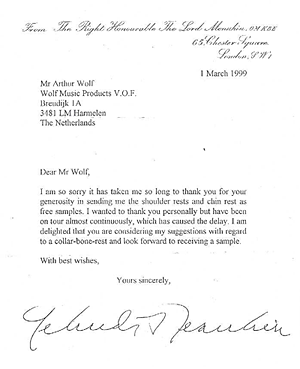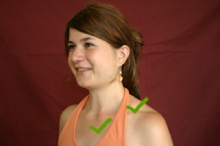From Shoulder Rest to Collar Bone Rest
2. A Basic problem
Secured shoulder rest vs. healthy playing position
For engineering purposes, to insure that the shoulder rest is securely clamped onto the instrument, it is necessary that the shoulder rest clamps be on opposite sides of the back of the instrument. However, this positions the rest in such a way that it often presses on the tip of the shoulder (acromion) of the player, restricting movement. Musicians struggle to solve this problem in many ways including making their own adjustments to store bought shoulder rests, using sponges or cushions, or giving up shoulder rests altogether. Positioning the shoulder rest differently on the instrument is sometimes the simplest option, but not the solution for every player. Highly adjustable models work the best when changing the position.
Menuhin and Wolf: the “collar-bone-rest”
Lord Yehudi Menuhin was also looking for a solution to this problem. In this letter written by him to the shoulder rest manufacturer Willy Wolf on March 1st 1999 he requests further help to develop a collar bone rest*:
“I am delighted you are considering my suggestions with regard to a collar-bone-rest and look forward to receiving a sample.” – Menuhin
Willy Wolf’s son Arthur Wolf had written in answer to Menuhin’s previous letter on January 14, 1999:
“My father….about twenty years ago…made a collar-bone-rest but…it was a problem to get enough stability on the violin. In the meantime we take your remarks very seriously and we will look into this matter again and we hope to send you a sample in one or two weeks.” - Arthur Wolf
As Menuhin died on the 12th of March 1999, only eleven days after his last letter to Wolf, this plan was abandoned.

Earlier in his life, Lord Yehudi Menuhin had already developed a collar bone rest that freed the shoulder joint and chest muscles for movement. His collar bone rest is no longer found in stores. With the position of the original Menuhin collar bone rest as an example, we adjusted the position of the shoulder rest to suit each of our players, also adding adjustments to height, shape and size.
*Letters given to the researcher by Willy Wolf in October 1999.
During our study we found that the position of the shoulder rest often dictated a position of the violin that made bowing and fingering difficult:
| This clamping position of the shoulder rest | often puts pressure on the left shoulder joint blocking its movement |  |
and positions the violin out of alignment with the bow arm | |
 |
 |
 |
This overstretch of the bow arm joints is so common that it is often overlooked as a source of bowing difficulties, and, in some cases, even incorporated into playing technique as desirable.
| Moving shoulder rest towards the violin tailpiece | takes pressure off the shoulder joint allowing it to move |  |
and aligns violin position with bow arm | |
 |
 |
 |
Custom made shoulder rests
The Menuhin rest is no longer made, and the original design was not adjustable to different body types. Together we created a variety of solutions for the players (see below). Towards the end of the research our technician developed a method of forming solid rubber blocks into custom made shoulder rests designed individually for the each player. This is our own version of the “collar bone rest.”

The custom made shoulder rest is positioned from the middle of the collar bone to the top of the breast bone to allow for free movement of the shoulder joint and chest muscles. It is further formed to match the curve of the violin and the curve of the body of the individual player, forming a complex wedge shape. This gives the correct height at each point of contact to provide sufficient support. Because the material is hard rubber, and the position of the rest is towards the tailpiece, the sound is not dampened as it would be with a sponge.
One of our custom made shoulder rests
